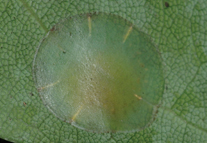Abstract
Limited knowledge regarding the biology and identification of the Australian tick Ixodes myrmecobii exists with only the female described to date. Here we provide a description of the male and nymph as well as a redescription of the female. All described stages are molecularly characterised using the cytochrome c oxidase subunit 1 (CO1) and internal transcribed spacer 2 (ITS2) loci. An updated list of hosts is presented including the first records from humans, cattle and several native species. Information on the distribution and conservation status of this species is also included.
References
Barker, S.C. & Walker, A.R. (2014) Ticks of Australia. The species that infest domestic animals and humans. Zootaxa, 3816 (1), 1–144.
https://doi.org/10.11646/zootaxa.3816.1.1Barker, S.C., Walker, A.R. & Campelo, D. (2014) A list of the 70 species of Australian ticks; diagnostic guides to and species accounts of Ixodes holocyclus (paralysis tick), Ixodes cornuatus (southern paralysis tick) and Rhipicephalus australis (Australian cattle tick); and consideration of the place of Australia in the evolution of ticks with comments on four controversial ideas. International Journal for Parasitology, 44, 941–953.
https://doi.org/10.1016/j.ijpara.2014.08.008Calaby, J. (1960) Observations on the banded anteater, Myrmecobius f. fasciatus Waterhouse (Marsupialia), with particular reference to its feeding habits. Proceedings of the Zoological Society of London, 135, 183–207.
https://doi.org/10.1111/j.1469-7998.1960.tb05841.xChitimia, L., Lin, R.Q., Cosoroaba, I., Wu, X.Y., Song, H.Q., Yuan, Z.G. & Zhu, X.Q. (2010) Genetic characterization of ticks from southwestern Romania by sequences of mitochondrial cox1 and nad5 genes. Experimental and Applied Acarology, 52, 305–311.
https://doi.org/10.1007/s10493-010-9365-9Clifford, C.M., Sonenshine, D.E., Keirans, J.E. & Kohls, G.M. (1973) Systematics of the subfamily Ixodinae (Acarina: Ixodidae). 1. The subgenera of Ixodes. Annals of the Entomological Society of America, 66, 489–500.
https://doi.org/10.1093/aesa/66.3.489Greay, T.L., Oskam, C.L., Gofton, A.W., Rees, R.L., Ryan, U.M. & Irwin, P.J. (2016) A survey of ticks (Acari: Ixodidae) of companion animals in Australia. Parasites & Vectors, 9, 1–10.
https://doi.org/10.1186/s13071-016-1480-yGuglielmone, A.A., Robbins, R.G., Apanaskevich, D.A., Petney, T.N., Estrada-Peña, A., Horak, I.G., Shao, R. & Barker, S.C. (2010) The Argasidae, Ixodidae and Nuttalliellidae (Acari: Ixodida) of the world: a list of valid species names. Zootaxa, 2528, 1–28.
International Union for Conservation of Nature (2016) The IUCN red list of endangered species. Bettongia penicillata. Available from: http://www.iucnredlist.org/details/2785/0 (accessed 1 March 2016)
Jongejan, F. & Uilenberg, G. (2004) The global importance of ticks. Parasitology, 129, 3–14.
https://doi.org/10.1017/S0031182004005967Kimura, M. (1980) A simple method for estimating evolutionary rates of base substitutions through comparative studies of nucleotide sequences. Journal of Molecular Evolution, 16, 111–120.
https://doi.org/10.1007/BF01731581Koch, C.L. (1844) Systematische übersicht über die Ordnung der Zecken. Archiv für Naturgeschichte, 10, 217–239.
https://doi.org/10.5962/bhl.part.29560Kumar, S., Stecher, G. & Tamura, K. (2016) MEGA7: Molecular Evolutionary Genetics Analysis version 7.0 for bigger datasets. Molecular Biology and Evolution, 33, 1870–1874.
https://doi.org/10.1093/molbev/msw054Kwak, M.L., Beveridge, I., Koehler, A.V., Malipatil, M., Gasser, R.B. & Jabbar, A. (2017) Phylogenetic analysis of the Australasian paralysis ticks and their relatives (Ixodidae: Ixodes: Sternalixodes). Parasites & Vectors, 10, 122.
https://doi.org/10.1186/s13071-017-2045-4Latreille, P.A. (1795) Observations sur la variété des organes de la bouche des tiques, et distribution méthodique des insectes de cette famille d'après les caractères établis sur la conformation de ces organes. Magasin Encyclopédique, ou Journal des Sciences, des Lettres et des Arts, 4, 15–20.
Mihalca, A.D., Gherman, C.M. & Cozma, V. (2011) Coendangered hard-ticks: threatened or threatening. Parasites & Vectors, 4, 1–7.
https://doi.org/10.1186/1756-3305-4-71Nuttall, G.H.F. & Warburton, C. (1911) Ticks, a Monograph of the Ixodoidea. Part II. The Genus Ixodes. Cambridge University Press, London, pp. 133–293.
Roberts, F.H.S. (1962) Ixodes (Sternalixodes) myrmecobii sp. n. from the numbat, Myrmecobius fasciatus fasciatus Waterhouse, in Western Australia (Ixodidae: Acarina). Journal of the Entomological Society of Queensland, 1, 42–43.
https://doi.org/10.1111/j.1440-6055.1962.tb00169.xRoberts, F.H.S. (1970) Australian Ticks. CSIRO Publishing, Melbourne, 267 pp.
Song, S., Shao, R., Atwell, R., Barker, S. & Vankan, D. (2011) Phylogenetic and phylogeographic relationships in Ixodes holocyclus and Ixodes cornuatus (Acari: Ixodidae) inferred from COX1 and ITS2 sequences. International Journal for Parasitology, 41, 871–880.
https://doi.org/10.1016/j.ijpara.2011.03.008Towns, D.R. & Ferreira, S.M. (2001) Conservation of New Zealand lizards (Lacertilia: Scincidae) by translocation of small populations. Biological Conservation, 98, 211–222.
https://doi.org/10.1016/S0006-3207(00)00156-7

